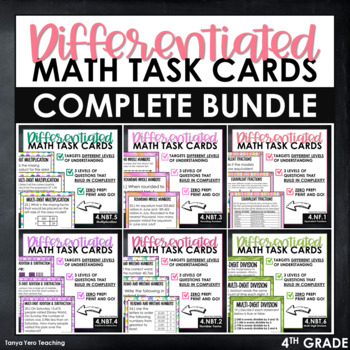4th Grade Math Task Cards Differentiated Math Centers Complete Yearlong Bundle
- Zip
What educators are saying
Description
Having quality math questions on hand has never been so easy! This resource includes 24 ready to print task cards that cover a specific math standard. The questions are divided into 3 levels so you can differentiate with ease and ZERO prep. Have confidence in knowing that you have questions that cover both procedural and conceptual understanding.
The questions build in complexity and cover different levels of depth and understanding. A small icon in the top right corner of each card identifies the level.
*****Grab this COMPLETE bundle at a discounted price! 672 math questions are waiting for you here!*****
Schedule of the domains to be released:
- Numbers and Operations in Base Ten: available now!
- Operations and Algebraic Thinking: available now!
- Fractions: available now!
- Geometry: available now!
- Measurement: available now!
Use these math task cards for:
- Small group instruction
- Questions for your math lessons
- Student work during math centers
- Math spiral review
- Math test prep
- Early finishers/ fast finishers
- ANY WAY YOU WANT!
What's included?
- 24 math questions per standard
- Recording sheet for easy student use
- Answer key
Benefits of this resource:
- Whether you are in a traditional classroom setting, completing distancing learning, or a mix of both you’ll have high quality math questions
- NO PREP
- Academically engaging
- High interest topics
- Promotes problem solving
- Designed to build in rigor
Who should purchase this resource?
- Teachers looking for resources that can be used in the classroom and for distance learning
- Teachers looking for resources that require deep thinking
- Teachers looking for READY TO GO math activities
- Teachers wanting ZERO PREP math activities





